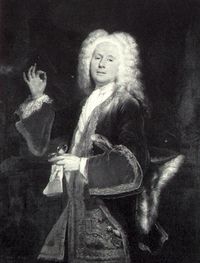Annotation:Lord Foppington (1): Difference between revisions
No edit summary |
No edit summary |
||
| Line 2: | Line 2: | ||
---- | ---- | ||
<p><font face="garamond, serif" size="4"> | <p><font face="garamond, serif" size="4"> | ||
'''LORD FOPPINGTON [1].''' AKA and see "[[Pilgrim (The)]]." English, Country Dance Tune ( | '''LORD FOPPINGTON [1].''' AKA and see "[[Pilgrim (The)]]." English, Country Dance Tune (6/4 or 6/8 time). C Major. Standard tuning (fiddle). AAB. The tune appears first in print in Walsh and Hare's '''The Compleat Country Dancing Master''' (London, 1718, p. 285), reprinted in subsequent editions of the volume in 1735 and 1754. | ||
<br> | <br> | ||
<br> | <br> | ||
Revision as of 02:31, 11 April 2014
Back to Lord Foppington (1)
LORD FOPPINGTON [1]. AKA and see "Pilgrim (The)." English, Country Dance Tune (6/4 or 6/8 time). C Major. Standard tuning (fiddle). AAB. The tune appears first in print in Walsh and Hare's The Compleat Country Dancing Master (London, 1718, p. 285), reprinted in subsequent editions of the volume in 1735 and 1754.

Lord Foppington was a character in the comic play The Relapse, Or, Virtue in Danger [1] (1696), by Sir John Vanbrugh [2] (1664-1726), closely based on actor and playwright Colley Cibber's (1671-1757) "Frenchified" character Sir Novelty Fashion, who had been introduced in his slightly earlier 1696 comedy Love's Last Shift, Or, Virtue Rewarded. Vanbrugh even copied Cibber's character's vanity, mannerisms, pratfalls and womanizing, and supposes that Sir Novelty purchased the the title of "Lord Foppington" through the corrupt system of Royal title sales.
The plays were huge successes, helped in part by Cibber's performance in both as Lord Foppington.
Not only was Vanbrugh a popular and accomplished playwright, but he was a renowned architect who designed the magnificent Blenheim Palace and Castle Howard, and who is credited with founding the English Baroque style.
Source for notated version:
Printed sources: Barnes (English Country Dance Tunes), 1986.
Recorded sources:
